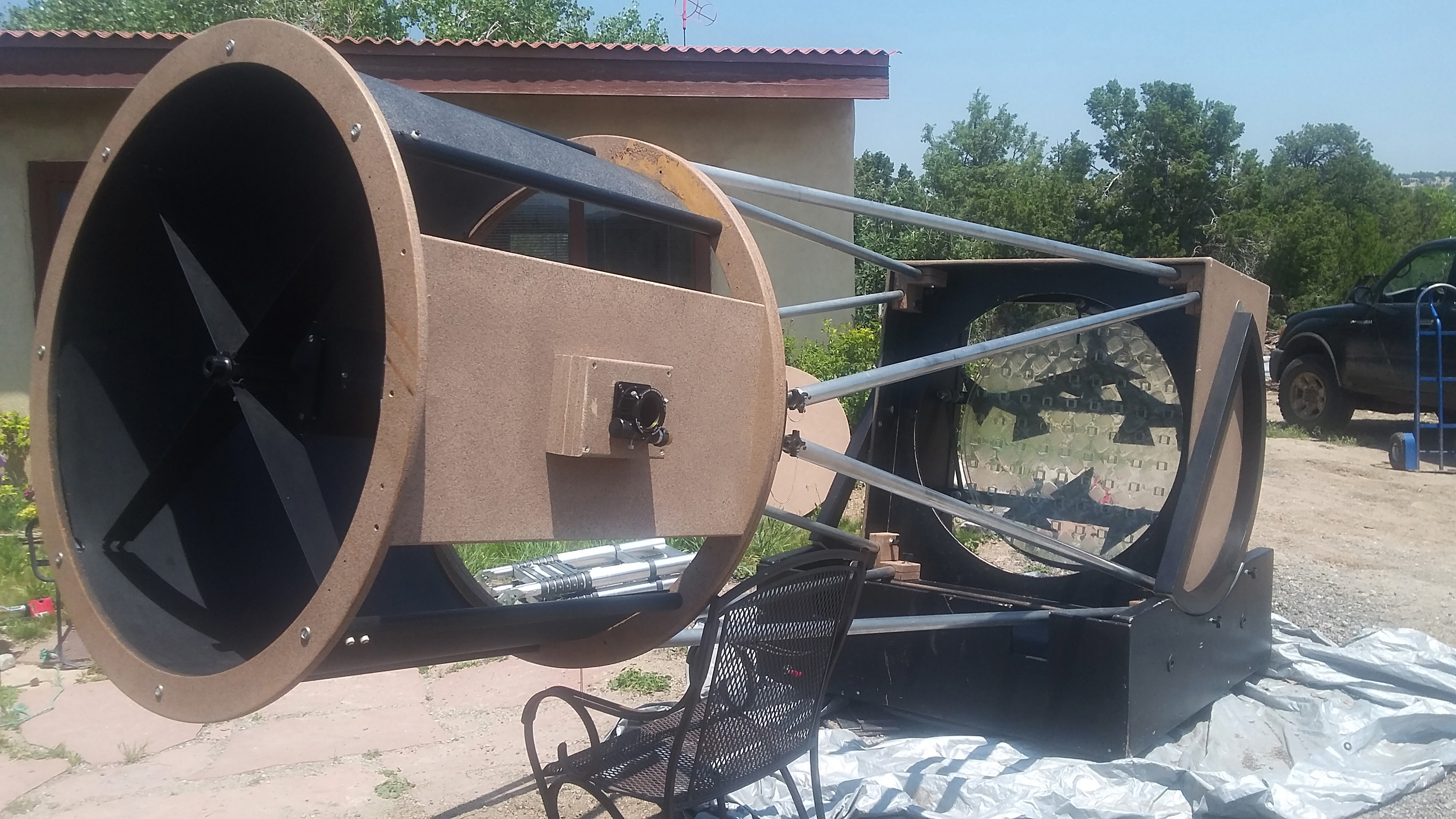Grand Plans for a Grand Scope
February 1, 2023

Photo courtesy Colin Nicholls
This donated 36-inch diameter, 12-foot, 6-inch tall Dobsonian telescope will be a stargazer's dream on the UNM-Taos Klauer campus.
With the intent to strengthen the overall campus experience, community, and culture of the campus and Northern New Mexico, UNM-Taos is presented with a unique opportunity to expand and improve outreach, presentation, study, and preservation of one of the world’s most precious natural resources: the night sky.
The late Melinda King of Las Trampas, New Mexico graciously donated a 36-inch diameter, 12-foot, 6-inch tall Dobsonian telescope to UNM-Taos. “It’s bigger than the largest telescope we have. The mirror is 3 feet across,” said an elated Colin Nicholls, MA D.Phil., UNM-Taos Assoc. Professor and Science Dept. Chair. “That’s very big.”
The new UNM-Taos scope is the largest public-use telescope in New Mexico, Arizona, and Colorado and one of the largest in the country. The 36-inch aperture parabolic primary mirror (914mm) collects over 1,000 square inches of light — over six times the light of the largest scope UNM-Taos currently has, which is a 14-inch Schmidt Cassegrain. The 36-inch scope is a huge light bucket, so to speak. The mirror is composed of two thick plates of glass separated by glass blocks that keep it stiff and stable. That assures good optical performance, even as the temperature drops.
“The purpose of a big scope is to see very faint details. It will be able to see objects that are six to 10 times dimmer than we can currently see with our largest scopes,” Nicholls explained. “We will be able to see 65 million light years away. What looks like a little smudge in our current scope, this new one will see details.”
For no fee, stargazers will be able to see the Virgo Cluster, for example, in some detail. It’s the closest large galaxy cluster to Earth’s Milky Way.
The purpose and value of the campus observatory are to provide engaging, hands-on experiences to students and community members of all ages; create a space to carry out observational studies and outreach activities; and educate students and the local community on the natural resource that is the night sky.
“The idea is to get people to come out and look through it,” Nicholls said.
The Dobsonian telescope’s design was developed in the 1950s by self-taught stargazer and itinerant monk John Dobson in San Francisco. He purposely designed the telescopes to be made inexpensively for public use — for the “sidewalk astronomers.” Over five decades, he showed thousands of people how to make his telescopes. Dobson, the “Johnny Appleseed of amateur astronomy,” died in 2014 at the age of 98. A lifelong passion for the hobby led to his expulsion, freeing him to share the simple joys of stargazing with others
At the moment, the telescope is disassembled. Nicholls said there’s a lot to do once the “stack of bits” are reassembled. The El Valle Astronomers club is tasked with putting it back together. Nicholls is the treasurer of the club.
One of those other things to do is build an observatory to house it, protect it, and allow for UNM-Taos students, local K-12 students, and the public to use it. The proposed ADA-accessible observatory plans include a classroom, a deck around the observatory so people can bring their own telescopes and play with UNM-Taos’ “little scopes,” more adequate light shielding from campus and roads with the addition of a berm, and an astronomy center — a 50-person capacity amphitheater/outdoor planetarium for presentations.
The plan is to locate the observatory/astronomy center behind the new Pathways building. An added path would run from the Pathways building to the observatory. Along it, Nicholls wants to erect a scale-version model of our solar system.
“The telescope will be ADA compliant,” Nicholls said. “The eyepiece is 11 and a half feet off the ground. We want to bring that down so people don’t have to climb a ladder to have a look. It just takes some engineering.”
Solutions to achieve ADA accessibility for use of the telescope are a lift, projection camera, or extended eyepiece, and a chairlift and assistant platform.
Dr. Mary Gutierrez, UNM-Taos Chancellor, has made a capital outlay request to the New Mexico Legislature for $1.3 million in funding to begin work on the observatory/astronomy center.
“We have completed a feasibility study, have worked with an architectural firm, and are consulting with the UNM Planning, Design & Construction project management team,” said Dr. Gutierrez. “So, we are ready for the next steps once we have secured funding.”
